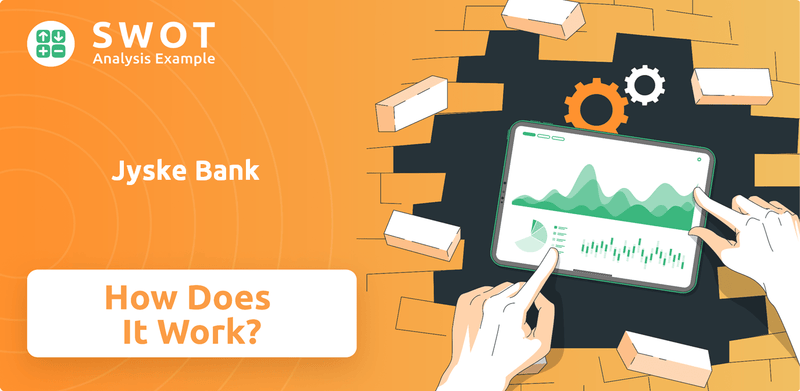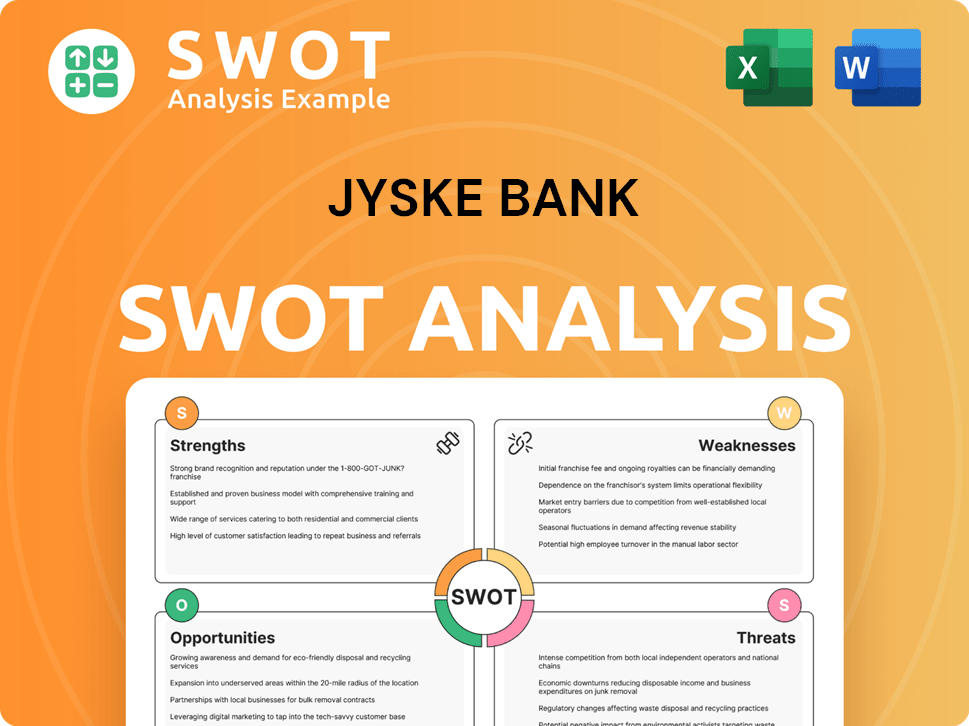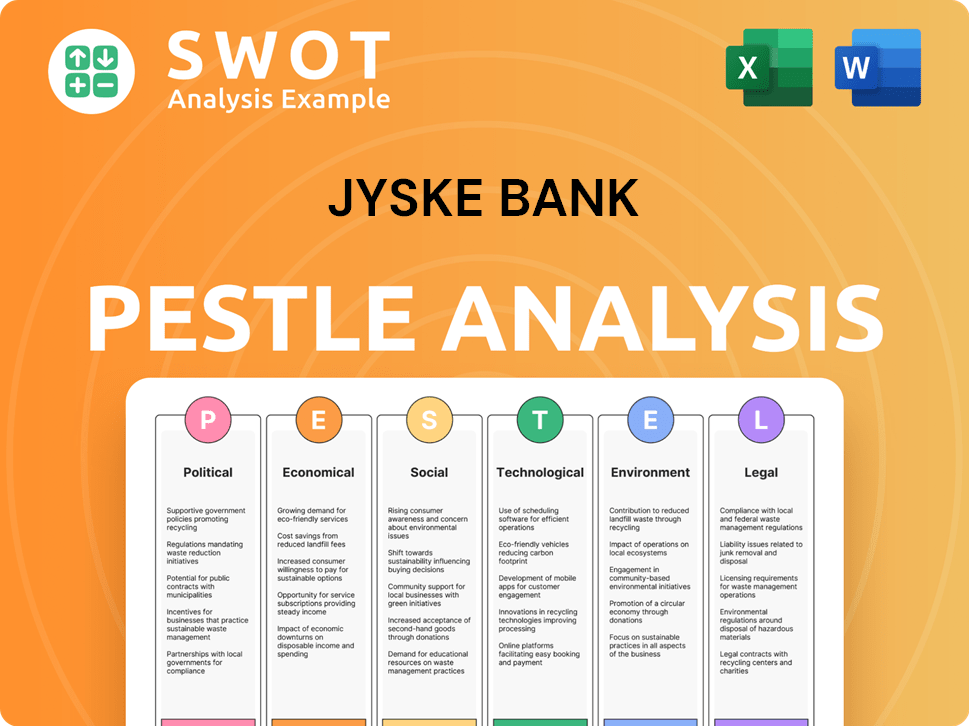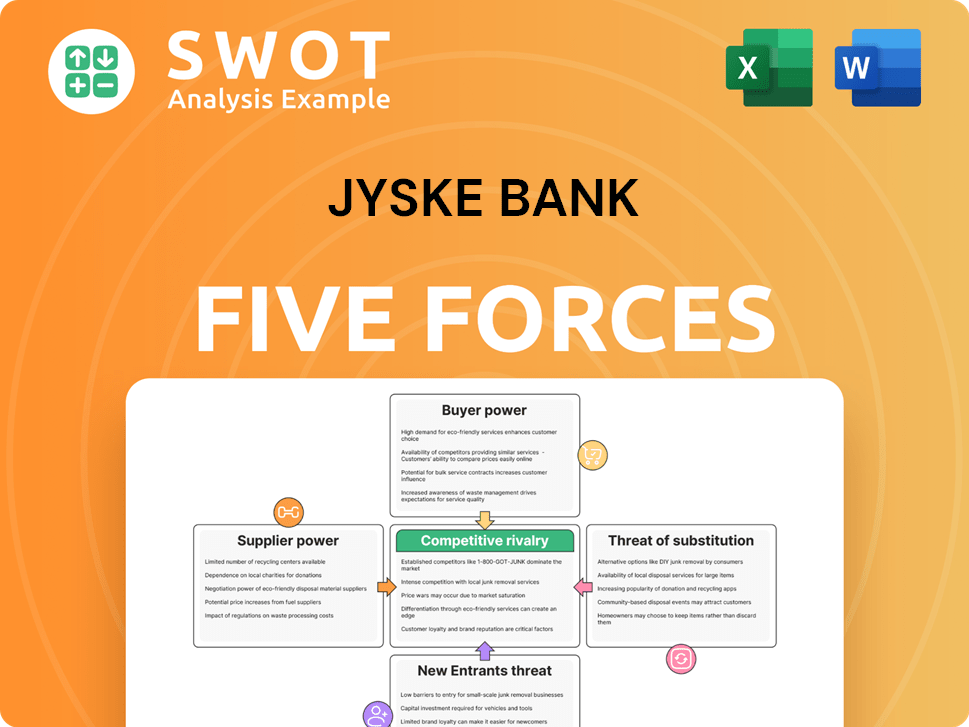Jyske Bank Bundle
How Does Jyske Bank Company Thrive in the Danish Market?
Jyske Bank, a leading Danish financial institution, has consistently demonstrated impressive financial results, making it a compelling case study for investors and industry professionals. In 2024, the Jyske Bank SWOT Analysis revealed the bank's strengths and opportunities. Its robust performance, including a record-breaking net profit, highlights its stability and strategic acumen within the competitive banking landscape.

This deep dive into Jyske Bank operations explores its comprehensive suite of banking services, from personal banking to business solutions, and how it adapts to challenges like fluctuating interest rates. The bank's commitment to customer satisfaction and digital transformation, along with its strategic revenue diversification, offers a valuable model for understanding sustainable growth in the financial sector. Discover how this Danish bank leverages its strengths to maintain a competitive edge and deliver value to its stakeholders.
What Are the Key Operations Driving Jyske Bank’s Success?
Jyske Bank, a prominent Danish bank, offers a comprehensive suite of financial products and services tailored to a diverse clientele. These services span personal, private banking, and corporate sectors, ensuring a wide reach within the financial landscape. The bank's core operations are designed to provide value through traditional banking, mortgage finance, asset management, and leasing solutions.
The Jyske Bank company distinguishes itself through its commitment to customer satisfaction and continuous technological advancements. This focus is evident in its strategic initiatives, including proactive digitization and support for customers' sustainable transitions. The bank's operational efficiency is enhanced by its extensive network of agencies and robust online and mobile banking platforms.
Jyske Bank operations are primarily focused within Denmark, with a small presence in Germany. This geographic concentration allows the bank to maintain a strong customer focus and effectively integrate acquisitions, such as Handelsbanken Danmark and PFA Bank. These core capabilities translate into improved service and comprehensive financial solutions for its customers.
Jyske Bank provides a broad range of financial services, including traditional banking, mortgage finance, asset management, and leasing. These services cater to personal, private banking, and corporate clients. The bank's offerings are designed to meet the diverse financial needs of its customers.
Jyske Bank prioritizes customer satisfaction through continuous improvements in service delivery. This includes enhancements to online and mobile banking platforms, as well as the integration of AI assistants. The bank's commitment to customer satisfaction is reflected in significant year-over-year increases across all segments.
The bank actively invests in technology to enhance customer experience and operational efficiency. This includes making all relevant meeting information available online and on mobile platforms. Corporate customers benefit from new online banking modules for financial and risk management.
Jyske Bank's operations are primarily concentrated in Denmark, with 99.9% of its revenue generated domestically. This strategic focus allows for a deeper understanding of the local market and stronger customer relationships. A small presence exists in Germany.
In Q1 2025, Jyske Bank saw significant improvements in customer satisfaction across all segments. Private Banking clients saw a 24% increase, Business/Corporate customers saw a 30% increase, and Personal customers saw a 7% increase. The Private Banking service has maintained the #1 position for nine consecutive years. Further insights can be found in the Growth Strategy of Jyske Bank.
- Introduction of AI assistants for all employees.
- New online banking modules for corporate clients.
- Focus on sustainable transition for customers.
- Continuous investment in technology and digital tools.
Jyske Bank SWOT Analysis
- Complete SWOT Breakdown
- Fully Customizable
- Editable in Excel & Word
- Professional Formatting
- Investor-Ready Format

How Does Jyske Bank Make Money?
The Jyske Bank company generates revenue through a variety of financial activities. Its primary revenue streams include banking operations, real estate and mortgage loans, and leasing services. This diversified approach helps the bank maintain financial stability and adapt to market changes.
Monetization strategies at Jyske Bank focus on both net interest income and net fee and commission income. The bank's ability to generate income from these diverse sources is crucial for its overall financial health and growth. This strategy allows the Danish bank to serve a wide range of customers and adapt to evolving market conditions.
As of the end of 2023, banking activities contributed 72.7% of the total revenue, real estate and mortgage loans accounted for 21.6%, and leasing made up 5.7%. This breakdown highlights the significance of core banking operations while also showing the importance of real estate and leasing in the bank's revenue mix.
In Q1 2025, core income was DKK 3,229 million, a 6% decrease from DKK 3,430 million in Q1 2024, primarily due to lower net interest income.
Net fee and commission income increased by 20% year-over-year in Q1 2025, driven by rising assets under management and increased investment product adoption. This growth reached its highest Q1 level on record.
For the full year 2024, core income was DKK 13,693 million, down from DKK 14,356 million in 2023. Despite declining net interest income, net fee and commission income rose by 6%.
The bank reported a net profit of DKK 5.3 billion in 2024, demonstrating its profitability despite market challenges.
The strategy for 2025 anticipates lower core income due to reduced net interest income and lower value adjustments, along with slightly higher core expenses.
The surge in fee income was partly due to a 31% year-over-year increase in sector lending offers.
The Jyske Bank company's financial performance in 2024 and its strategic outlook for 2025 highlight its ability to adapt to changing economic conditions. The bank's focus on diversifying its income streams, particularly by increasing net fee and commission income, has helped to offset the impact of lower net interest income. For more insights into the ownership and structure of the bank, you can read about the Owners & Shareholders of Jyske Bank.
The primary drivers of Jyske Bank's revenue include:
- Net interest income from loans and deposits.
- Fees and commissions from banking services, investment products, and trading activities.
- Income from real estate and mortgage loans.
- Leasing income.
Jyske Bank PESTLE Analysis
- Covers All 6 PESTLE Categories
- No Research Needed – Save Hours of Work
- Built by Experts, Trusted by Consultants
- Instant Download, Ready to Use
- 100% Editable, Fully Customizable

Which Strategic Decisions Have Shaped Jyske Bank’s Business Model?
The following details the key milestones, strategic moves, and competitive edge of the Jyske Bank company. The institution has a rich history, marked by significant developments that have shaped its current operations and financial performance. Recent strategic initiatives and a strong focus on customer satisfaction highlight the bank's commitment to growth and adaptation in the dynamic financial landscape.
A central strategy for Jyske Bank has been the successful integration of Handelsbanken Danmark and PFA Bank, which has yielded better-than-expected results and synergies. In addition, the acquisition of the Opendo leasing portfolio by Jyske Finans, announced in September 2024, is progressing as planned. These moves demonstrate the bank's proactive approach to expanding its market presence and enhancing its service offerings.
Jyske Bank has navigated market challenges, including a decline in net interest income due to lower interest rates. The bank has responded by diversifying its revenue streams, particularly by increasing net fee income. Risk management is also a priority, as demonstrated by the increase in post-model adjustments by DKK 0.1 billion in Q1 2025 to address potential impacts from trade war scenarios. This proactive stance underscores the bank's resilience and adaptability.
Jyske Bank's history is marked by significant milestones that have shaped its operations. The successful integration of Handelsbanken Danmark and PFA Bank is a recent highlight, demonstrating the bank's ability to execute strategic acquisitions effectively. The bank's focus on customer satisfaction and technological advancements has also been crucial.
Strategic moves for the Danish bank include expanding its revenue streams, particularly by boosting net fee income. The acquisition of the Opendo leasing portfolio by Jyske Finans is another strategic move. Jyske Bank continues to update its corporate strategy to strengthen its market position.
Jyske Bank's competitive advantages include strong brand strength and high customer satisfaction. The bank's technology leadership, including the introduction of AI assistants and enhanced online banking platforms, is also key. Its focus on digitization and a solid, secure platform are central to its strategy.
The bank has faced challenges, including a decline in net interest income. However, Jyske Bank has responded by diversifying revenue streams. The bank increased its post-model adjustments by DKK 0.1 billion in Q1 2025 to reflect potential impacts from trade war scenarios.
Jyske Bank's competitive edge is bolstered by several factors, including its strong brand and high customer satisfaction. The bank's commitment to technological advancements, such as AI assistants and improved online banking, also plays a key role. The bank's focus on digitization supports its strategic goals.
- Strong brand strength and high customer satisfaction, with significant year-over-year increases in customer satisfaction across all segments in Q1 2025.
- Private Banking service maintaining the #1 position for nine consecutive years.
- Technology leadership, introducing AI assistants and enhancing online and mobile banking platforms in Q1 2025.
- Focus on digitization and a solid, secure, and attractive platform.
Jyske Bank Business Model Canvas
- Complete 9-Block Business Model Canvas
- Effortlessly Communicate Your Business Strategy
- Investor-Ready BMC Format
- 100% Editable and Customizable
- Clear and Structured Layout

How Is Jyske Bank Positioning Itself for Continued Success?
Jyske Bank, a prominent Danish bank, holds a significant position in the financial landscape. As the third-largest independent bank in Denmark, it has cultivated strong customer loyalty. This is evident in the increasing inflow of personal customers, particularly with the highest growth of mortgage loans to personal customers in over five years in Q4 2024. The bank's assets under management grew by 17% in 2024, demonstrating its robust financial performance.
Despite its strong foundation, Jyske Bank faces several risks. The future economic outlook is influenced by higher geopolitical uncertainty and ongoing trade wars. The bank anticipates a slightly higher cost base in 2025 due to strategic investments and inflationary pressures. Net interest income is expected to decline due to lower interest rates impacting deposit margins. Regulatory changes, such as the implementation of Basel IV regulations in Q1 2025, pose further challenges. The Digital Operational Resilience Act (DORA) will also drive advancements in its ICT-risk management in 2025.
Jyske Bank is a leading Danish bank, holding a prominent position within the financial sector. Its strong customer base and growth in mortgage loans indicate a solid market presence. The bank's performance reflects its ability to attract and retain customers, crucial for its ongoing success. For more insights, explore a Brief History of Jyske Bank.
The bank faces risks from economic uncertainties and regulatory changes. Higher geopolitical uncertainty and trade wars could impact future development. The implementation of Basel IV regulations in Q1 2025 and the impact of DORA regulations are critical factors.
Jyske Bank maintains a positive outlook, with net profit guidance for 2025 in the range of DKK 3.8 billion to DKK 4.6 billion. Strategic initiatives include investments in customer segments and digitization. The bank targets a cost-income ratio below 50% and aims to keep cost development as flat as possible.
The bank's capital management objectives include a capital ratio within 20-22% and a CET1 ratio between 15% and 17%. Jyske Bank plans to distribute approximately 30% of shareholders' results via share buy-backs. The company's strategy focuses on customer focus and strategic acquisitions.
Jyske Bank's financial targets include maintaining profitability and enhancing shareholder value. These targets are supported by strategic initiatives and a focus on operational efficiency. The bank's ability to meet these targets is crucial for its long-term success and market position.
- Net profit guidance for 2025: DKK 3.8 billion to DKK 4.6 billion, corresponding to earnings per share of DKK 60-73.
- Cost-income ratio target: Below 50%.
- Capital ratio target: Within the range of 20-22%.
- Common Equity Tier 1 (CET1) capital ratio target: Between 15% and 17%.
Jyske Bank Porter's Five Forces Analysis
- Covers All 5 Competitive Forces in Detail
- Structured for Consultants, Students, and Founders
- 100% Editable in Microsoft Word & Excel
- Instant Digital Download – Use Immediately
- Compatible with Mac & PC – Fully Unlocked

Related Blogs
- What are Mission Vision & Core Values of Jyske Bank Company?
- What is Competitive Landscape of Jyske Bank Company?
- What is Growth Strategy and Future Prospects of Jyske Bank Company?
- What is Sales and Marketing Strategy of Jyske Bank Company?
- What is Brief History of Jyske Bank Company?
- Who Owns Jyske Bank Company?
- What is Customer Demographics and Target Market of Jyske Bank Company?
Disclaimer
All information, articles, and product details provided on this website are for general informational and educational purposes only. We do not claim any ownership over, nor do we intend to infringe upon, any trademarks, copyrights, logos, brand names, or other intellectual property mentioned or depicted on this site. Such intellectual property remains the property of its respective owners, and any references here are made solely for identification or informational purposes, without implying any affiliation, endorsement, or partnership.
We make no representations or warranties, express or implied, regarding the accuracy, completeness, or suitability of any content or products presented. Nothing on this website should be construed as legal, tax, investment, financial, medical, or other professional advice. In addition, no part of this site—including articles or product references—constitutes a solicitation, recommendation, endorsement, advertisement, or offer to buy or sell any securities, franchises, or other financial instruments, particularly in jurisdictions where such activity would be unlawful.
All content is of a general nature and may not address the specific circumstances of any individual or entity. It is not a substitute for professional advice or services. Any actions you take based on the information provided here are strictly at your own risk. You accept full responsibility for any decisions or outcomes arising from your use of this website and agree to release us from any liability in connection with your use of, or reliance upon, the content or products found herein.